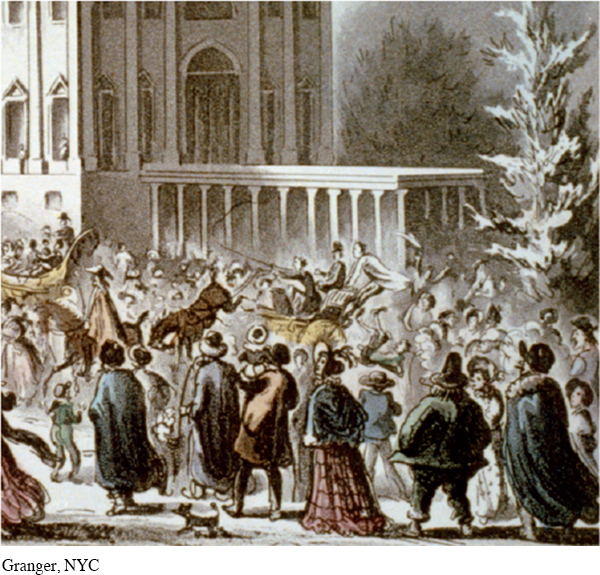Introduction to Chapter 9
9
Defending and Redefining the Nation
1809–1832
WINDOW TO THE PAST
Crowds Celebrate a Presidential Inauguration
When Andrew Jackson was elected president in 1828, he decided to open the traditional White House reception to ordinary women and men. Some people applauded his democratic inclusion; others were appalled by the “mob scene.” The event drew attention in Great Britain as well as the United States. This 1829 image is from President’s Levee, drawn by Robert Cruikshank, a British satirical artist. To discover more about what this primary source can show us, see Document 9.9.

LEARNING OBJECTIVES
After reading this chapter you should be able to:
Analyze the intertwined effects of conflicts with Britain and on the U.S. frontier on federal policies and the lives of white and Indian Americans.
Explain the role of state and federal governments in the nation’s expansion and how expansion affected relations among increasingly distinct regions.
Evaluate how the panic of 1819 and the Missouri Compromise affected and were affected by the nation’s economic expansion and political divisions.
Discuss how expanded voting rights for white working men, new racial restrictions, and continued debates over federal power led to political realignment.
Describe the challenges that President Jackson faced in implementing federal policies on the tariff, the national bank, and the removal of the Cherokee.
AMERICAN HISTORIES

Dolley Payne was raised on a Virginia plantation. But her Quaker parents, moved by the Society of Friends’ growing antislavery sentiment, decided to free their slaves. In 1783, when Dolley was fifteen, the Paynes moved to Philadelphia. There, Dolley’s father suffered heavy economic losses, and Dolley lost her first husband and her younger son to yellow fever. In 1794 the young widow met and married Virginia congressman James Madison. When the newly elected president Thomas Jefferson appointed James secretary of state in 1801, the couple moved to the new capital city of Washington.
Since Jefferson and his vice president, Aaron Burr, were widowers, Dolley Madison served as hostess for White House affairs. When James Madison succeeded Jefferson as president in 1809, he, too, depended on his wife’s social skills and networks. Dolley held lively informal receptions to which she invited politicians, diplomats, cabinet officers, and their wives. These social events helped bridge the ideological differences that continued to divide Congress and proved crucial in creating a unified front when Congress declared war on Great Britain in 1812.
During the War of 1812, British forces attacked Washington City and burned the Executive Mansion, now called the White House. With the president away, his wife was left to secure important state papers, emerging as a symbol of national courage at a critical moment in the conflict. When peace came the following year, Dolley Madison quickly reestablished a busy social calendar to help mend conflicts that had erupted during the war.

In 1817, at the end of the president’s second term, the Madisons left Washington just as a young trader named John Ross entered the political arena. Born in 1790 in the Cherokee nation, John (also known as Guwisguwi) was the son of a Scottish trader and his wife, who was both Cherokee and Scottish. John Ross was raised in an Anglo-Indian world in eastern Tennessee, where he played with Cherokee children and attended tribal events but was educated by private tutors and in Protestant missionary schools. At age twenty, Ross was appointed as a U.S. Indian agent among the Cherokee and during the War of 1812 served as an adjutant (or administrative assistant) in a Cherokee regiment.
After the war, Ross focused on business ventures in Tennessee, including the establishment of a plantation. He also became increasingly involved in Cherokee political affairs, using his bilingual skills and Protestant training to represent Indian interests to government officials. In 1819 Ross was elected president of the Cherokee legislature. In the 1820s he moved to Georgia, where he served as president of the Cherokee constitutional convention in 1827. Having overseen the first written constitution produced by an Indian nation, Ross was then elected principal chief in 1828. Over the next decade, he battled to retain the Cherokee homeland against the pressures of white planters and politicians.
The American histories of Dolley Madison and John Ross demonstrate that, while American politics was a white man’s game, it was sometimes possible for those on the political margins to influence national developments. Both Madison and Ross sought to defend and expand the democratic ideals that defined the young nation. The First Lady helped to nurture a bipartisan political culture in Washington, which was particularly important following the War of 1812. Dolley Madison also struggled with the issue of slavery, an issue that fueled tensions among Democratic-Republicans when Missouri sought admission to statehood in 1819. Missouri’s admission resulted from the nation’s rapid geographical expansion. Its economic development proved more volatile, however, with the nation suffering its first major recession in 1819. Working men then demanded the right to vote to protect their economic interests. The Cherokee also asserted their rights. Ross encouraged Cherokees to embrace Anglo-American culture as a path to inclusion. But he could not overcome the power of planters and politicians to wrest valuable territory from his tribe. President Andrew Jackson, elected in 1828, ensured Cherokee removal and supported slavery. Yet he was lauded as a democratic hero for his frontier background and promotion of workingmen’s rights. The United States successfully defended itself against British intervention, but still could not agree on which Americans truly belonged in the nation.
Exploring American HistoriesPrinted Page 275
Exploring American Histories Value EditionPrinted Page 205
Chapter Timeline